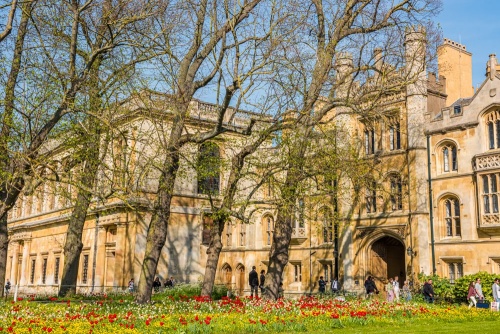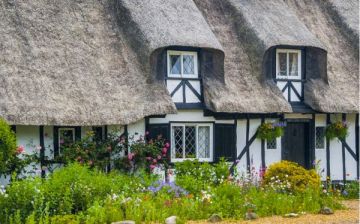
King Henry VIII founded Trinity College in 1546 by joining together two existing colleges, King's Hall and Michaelhouse. Of the two, Michaelhouse was the older college, established in 1324 by Hervey de Stanton, Chancellor of the Exchequer under Edward II. The buildings originally held by Michaelhouse now form the south part of Trinity's Great Range.
King's Hall, not to be confused with King's College, was founded in 1337, and its buildings now form the northern part of the Great Range at Trinity.
Henry VIII made sure that Trinity College was well endowed, with gifts of land and former monastic estates. Trinity became one of the richest and most prestigious of the Cambridge colleges, drawing to it the sons of many leading families of the realm.

Under Thomas Nevile, Master from 1593 to 1615, Trinity was expanded and its buildings unified to form the core of what we can see today. Nevile even paid for the building of Nevile Court out of his own pocket.
But it is Great Court that draws the immediate attention of visitors. It is the largest and most impressive court of any at Cambridge (and larger than any Oxford Quad, too).
Nevile was the mastermind of Great Court; he demolished the old hall and erected the present building, notable for its lantern and wonderful hammerbeam roof. Nevile even had the clock tower dismantled and moved, brick by brick, to its present position by the chapel.

The Great Court is entered through an imposing brick gateway dating from 1535. Above the entry is an imposing statue of Henry VIII, regally holding a chair leg! It seems that students kept removing the original sceptre held by the statue, so college porters designed this unusual replacement.
Lord Byron, when he attended Trinity, was known to keep a bear in his rooms. He would occasionally lead the bear around the college on a chain.
Outside the imposing entrance gatehouse is an apple tree, said to have been grown from a cutting from the tree that dropped an apple on Isaac Newton's head, prompting him to evolve his theory of gravity. Is the story true? There's no way of knowing for certain, but the college keeps the tree safe behind a chain barrier, just to be on the safe side.

WREN LIBRARY
The Library at Trinity College, which faces into Nevile's Court, was built to a design by Christopher Wren and finished in 1695. Wren designed not only the overall structure but even took a hand in the furniture! He brought in Grinling Gibbons to carve the limewood decorative elements as well as the royal coat of arms at each end of the building. Busts of notable Trinity members dot the interior, including a full-length marble statue of Lord Byron originally intended for Westminster Abbey.
Library Exhibits
There are 6 exhibition cases in the Library, with rotating displays from the Library's collection of books and manuscripts. Almost always displayed is the Library's prized possession, an 8th-century copy of Epistles of St Paul, as well as an autographed version of Milton's poems, A.A. Milne's Winnie-the-Pooh, and Newton's annotated Principia.
Opening Details for the Wren Library
Entry to the Wren Library is free, but a charge applies to enter the college. If you want to visit just the library, enter by Queen's Road or Garret Hostel Lane

FAMOUS TRINITY MEMBERS
Isaac Newton
John Dryden
Thomas Macaulay
Lord Byron
William Thackeray
Alfred, Lord Tennyson
Bertrand Russell
A.E. Housman
Visiting Trinity College
The main college entrance is on Trinity Street, immediately south of St John's College. Opening times vary, and there is a much greater chance of the college being open out of term times.
Even if there is no direct access to the college interior and chapel you can usually explore the river frontage easily. From the gateway on Trinity Street walk a few steps south to Trinity Lane, a narrow byway that leads to Garret Hostel Lane.

Follow the lane as it skirts the wall of New Court. Before you reach Garret Hostel Bridge there is a gateway on the right that gives access to a boating yard, and also to Brewhouse Lawn and Scholars' Lawn, wide green spaces that lead from Trinity College's imposing rear facade down to the River Cam.
You can also cross the footbridge to the even larger green spaces of South Paddock and North Paddock, where you can walk along the riverbank and enjoy superb views of the college and its neighbours.
About Trinity College
Address: Trinity Street,
Cambridge,
Cambridgeshire,
England, CB2 1TQ
Attraction Type: Historic Building
Website: Trinity College
Location
map
OS: TL448 587
Photo Credit: David Ross and Britain Express
HERITAGE
 We've 'tagged' this attraction information to help you find related historic attractions and learn more about major time periods mentioned.
We've 'tagged' this attraction information to help you find related historic attractions and learn more about major time periods mentioned.
Find other attractions tagged with:
Henry VIII (Person) -
NEARBY HISTORIC ATTRACTIONS
Heritage Rated from 1- 5 (low to exceptional) on historic interest
Round Church, Cambridge - 0.1 miles (Historic Church) ![]()
Gonville and Caius College - 0.1 miles (Historic Building) ![]()
Trinity Hall - 0.1 miles (Historic Building) ![]()
St Johns College - 0.1 miles (Historic Building) ![]()
Sidney Sussex College - 0.2 miles (Historic Building) ![]()
Cambridge, Great St Mary's Church - 0.2 miles (Historic Church) ![]()
Cambridge Arts Theatre - 0.2 miles () ![]()
Christ's College, University of Cambridge - 0.2 miles (Historic Building) ![]()
Nearest Holiday Cottages to Trinity College:
Fulbourn, Cambridgeshire
Sleeps: 2
Stay from: £290 - 1174
More self catering near Trinity College



